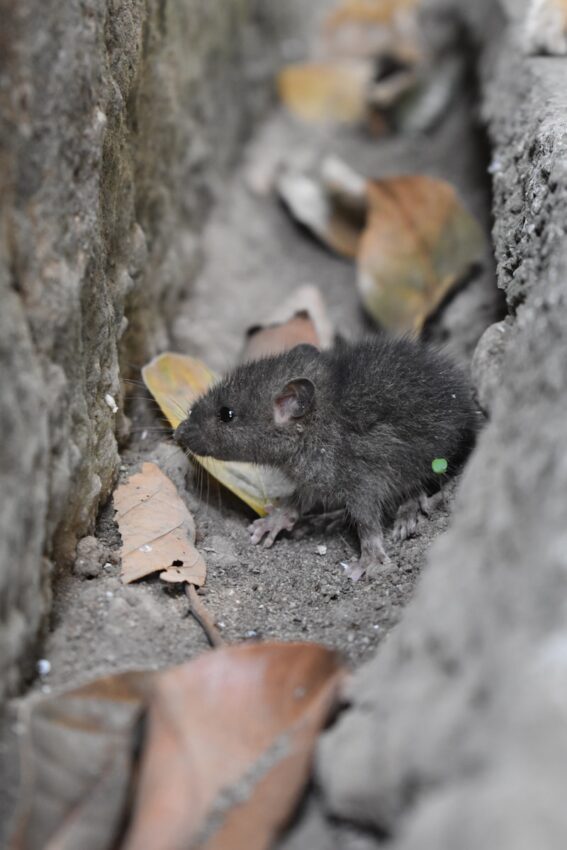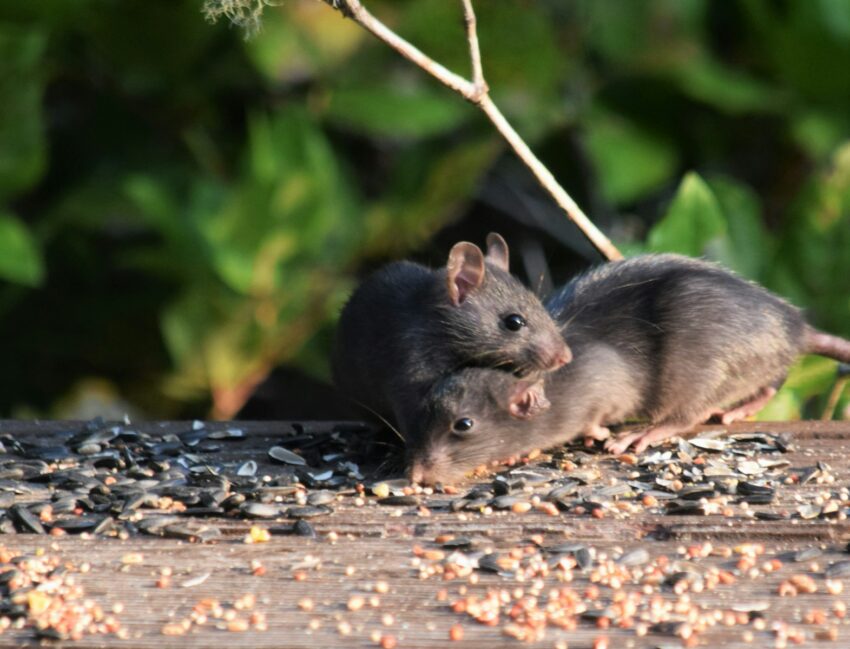Mice are infamous pests that are known to cause damage. They are among the most widespread and damaging pests; they gnaw through food containers, electrical wires, and walls. Because of their intelligence and environmental adaptability, they are especially challenging to manage.
Additionally, mice can infect humans with diseases. Contact with mice’s urine, saliva, or feces, or even just handling them directly, can result in this.

It’s critical to act quickly if you think mice are on your property because they can cause expensive damage and multiply quickly.
Below, we will answer the question “How much is pest control for mice?” in detail, and the kinds of services you can anticipate throughout this process.
Signs of a Mouse Infestation
Since mice prefer to appear at night, it can be difficult to detect an infestation. Even though you might not see these mice at work, they do leave behind some telltale signs, such as:
- Droppings: This is the most important indicator to look for. Mice will leave their droppings almost anywhere, and they are fairly easy to find. They are nearly the size of rice grains, dark in color, and slightly moist when fresh, but they gradually begin to dry out. They are typically located in hard-to-reach areas, such as cabinet corners and beneath sinks.
- Nests: Mice also have a need for a warm and comfortable home, which they can obtain by gathering a variety of materials, such as fabrics and sawdust, in small, dark, and isolated areas.
- Gnaw Marks: The incisors of mice grow over the course of their lives. They occasionally gnaw through cardboard, plastic, wires, wood, and even metal to keep their teeth healthy in addition to gaining access to food. Because of this, they always gnaw on items near your house, which is one of the quickest ways to determine whether your house or place of business has been infested. You can look for these marks on clothing, furniture, and electrical wires.
- Smudge Marks: Mice frequently leave behind dark smudge marks of oil and dirt when they move along walls or baseboards.
- Musky Scent: This is yet another clear-cut method of locating a mouse’s hiding place. You can use the fact that mice follow their own scent and consistently return to the same location to determine their precise location.
- Odd Pet Behavior: When they detect mice, dogs and cats will paw under refrigerators, stare at walls, or even bark.
- Scratching Noises: Mice are particularly known to make noise as they scratch and chew. You should hire pest control professionals because this is an obvious indication of an infestation.
Since mice can cause structural damage and multiply quickly, you should get in touch with a pest control company if you are seeing any of these symptoms.

Do Mice Pose a Risk?
Mice aren’t harmful in general, but they can be dangerous in a number of ways. They have been linked to a number of severe diseases and health hazards. The Centers for Disease Control (CDC) claim that mice are responsible for the spread of many diseases around the world.
You run the risk of getting bitten by a mouse if you attempt to manage an infestation on your own. When you come into contact with mouse saliva, you may expose yourself to a number of diseases. However, mouse diseases can also be transmitted indirectly by ticks, fleas, and mites that feed on the infected mouse and subsequently spread the infection to people.
Diseases That Are Spread by Mice
Mice tend to urinate and defecate everywhere to identify a location as their own. Mice excrement is undoubtedly untidy and unpleasant, but it also contains several known pathogens that can cause serious health issues. Here are some examples:
- Hantavirus: Deer mice are the most common species to exhibit this. The virus, which is present in rodent urine and feces, can infect humans if they come into contact with either of those. Additionally, mouse urine and feces can dry out and turn into dust, which can also spread the virus. Like so many other illnesses, hantavirus begins with chills and fever, followed by aches and pains. If left untreated, though, it can rapidly worsen and result in breathing difficulties and renal failure, both of which can be fatal.
- Salmonella: Mice and other rodents search for food and will consume almost anything that catches their small paws and sharp teeth. This implies that they will carry dirt and bacteria to other food items that may be present by walking over kitchen counters or throughout your pantry and cabinets. Salmonella, commonly known as food poisoning, is one of the most harmful of those. The symptoms, which can become extremely dangerous and serious, include fevers, severe stomach cramps, vomiting, and diarrhea.
- Lymphocytic Choriomeningitis (LCMV): This is a viral infectious disease that is spread by rodents and causes major neurological issues, such as encephalitis (inflammation of the brain) and aseptic meningitis (inflammation of the meninges surrounding the brain and spinal cord). People contract LCMV when they come into contact with fresh urine, saliva, droppings, or nesting materials.
Another thing to keep in mind is that mice are frequently covered by parasites like fleas and ticks. A number of illnesses have been connected to parasites that mice carry, such as:
- Lyme disease: Ticks, which mice frequently carry with them, are the vectors of this disease. It is easy for ticks to turn into an infestation, and they can spread this dangerous disease that can have long-term consequences.
- Colorado Tick Fever: This is yet another extremely dangerous and potentially fatal illness spread by ticks that rodents like mice carry.
Eliminating mice from your house involves more than just preventing holes from being chewed into your furniture; leaving them unchecked can be hazardous. Make sure you follow the right procedures and, if required, seek medical attention if you have come into contact with mice.
Is My Home Susceptible to Damage from Mice Infestations?
Mice are dangerous in your house because they are always chewing. Because mice need to chew to keep their teeth long, they may chew through rubber, drywall, plastic pipes, insulation, aluminum, and possibly wires or gas lines.
Chewing-related openings should be covered, but they don’t immediately endanger you or your family. However, the risk of a fire starting is increased if rodents chew through wires, and the risk of carbon monoxide poisoning is increased if gas lines leak.
How Much Is Pest Control for Mice?
Now that you understand the urgency of addressing a mouse infestation, down below, we will be talking about some factors to take into account when estimating the final cost.
Every infestation is unique, and the complexity—and cost—of the pest control process can vary depending on the circumstances of a given home. The answer to the question, “How much is pest control for mice?” may therefore be more complicated than it first appears.
The cost and extent of the pest control techniques will usually increase with the size of your infestation. It is simple to use live traps when there are not many mice around. However, it will be necessary to use several techniques if there is a colony of a larger infestation. Here are some factors to consider:
Inspection
Inspections identify the infestation’s location, extent, and necessity for any necessary repairs. In order to provide a plan and an estimate, pest control companies frequently provide a free inspection and consultation.
Some businesses do charge an inspection fee, but if the customer chooses to use their services, the fee is waived. Depending on the size of the house, inspections that aren’t free or waived typically cost between $100 and $250.
Severity of Infestation
The most effective pest control techniques and the number of follow-up visits required after the initial visit will depend on the size of the infestation. After all, an advanced infestation cannot be eradicated by the best mouse traps.
While a large problem can cost between $1,500 and $2,500 to fix, a small infestation can be removed for as little as $200 to $400.
Location of Nests
The cost will be higher for nests hidden in places that are hard for the pest control expert to reach for removal, bait, or traps. As there is more terrain to protect in very large spaces, costs will also go up. For instance, controlling mice in a barn can cost up to $1,000, but solving a mouse problem in a shed will only cost $200 at most.
Here are some average costs:
- Attic: $250 to $475
- Bedroom: $250 to $425
- Ceiling: $300 to $400
- Garage: $550 to $750
- Kitchen: $250 to $425
- Roof: $150 to $300
- Walls: $450 to $600
Size of the House
Plans for pest control are tailored to the size of the area that needs to be treated. A bigger area requires more equipment for removal, more time for setup, more work to fix possible entry points, more monitoring, and consequently higher costs.
Here are some approximate costs regarding the size of your house:
- 1,000 – 2,000 square feet: $200 to $400
- 2,000 – 3,000 square feet: $400 to $700
- 3,000 – 4,000 square feet: $700 to $1,000
- 4,000 – 5,000 square feet: $1,000 to $1,200
Method of Removal
The kind of property and level of infestation determine how much live removal will cost. The least expensive part is trapping, and the main cost is moving the trapped mice.
Fumigation is the costliest option because it requires extensive cleanup after the process is finished and charges are calculated by square foot.
- Traps: $300 to $700
- Poison: $350 to $650
- Bait stations: $500 to $700
- Fumigation: $2,500 to $7,000
Extra Expenses and Factors to Consider
Homeowners still have tasks to complete after getting rid of mice, and if they don’t account for these additional expenses, they risk re-infestation. Although not all of these expenses will be relevant in every circumstance, they still should be kept in mind.
Repairing Damage
The residents of the house should have a clear understanding of the types of repairs that might be required based on the pest control company’s inspection. Repairing issues like chewed drywall, gnawed electrical wires, and broken HVAC systems can get expensive very fast.
The expenses can quickly increase if a mouse chewed through a pipe and caused a leak because the homeowner will have to pay for plumbing repair in addition to repairs for the walls, ceiling, and floor, as well as any possible mold or mildew damage.
For instance, your costs may stem from something as basic as repairing your drywall, which can cost anywhere from $350 to $800, or from something more expensive, like cleaning up water, which can cost anywhere from $1,200 to $5,000.
Thorough Cleaning
Although basic cleanups, such as removing traps, bait stations, and dead mice, will be handled by pest control professionals, many homeowners opt to have a professional cleaning service come in after the pest control procedure is finished to give the house a thorough makeover and get rid of any remaining rodent traces.
It costs between $100 and $250 to hire a cleaning service but doing so could result in a hygienic home and peace of mind.
Methods for Reducing the Cost of Pest Control for Mice
Pest control for mice isn’t always as costly as other home renovations or repairs, but because it’s typically an emergency, it can be challenging to fit into the budget. Homeowners can keep this project affordable by taking a look at the following tips when weighing their options:
- Minimize the likelihood of infestation: Eliminate mouse-attracting items, such as water sources and food trails, by keeping food out of reach.
- Contact experts while the issue is still minor: By contacting pest control experts as soon as you become aware of a possible mice infestation, you enable them to deal with the issue before it becomes too big and costly.
- Consider a pest control service contract: You can be certain that the service contract will pay for itself quickly if you find yourself calling professionals multiple times a year. In addition, the service might be applicable to other invasive pests and in different locations all year long.
- Do the deep cleaning yourself: Instead of hiring a professional house cleaner, residents can use at-home cleaning supplies to remove minor infestations after the pest control process for mice is done.
FAQ
Is Hiring a Mouse Pest Control Specialist Worthwhile?
Yes, hiring a pest control professional is often worth the cost. Renters or homeowners with a reasonable level of skill can manage very minor infestations, but once it’s determined that there are more than a few mice, it’s time to hire a professional. Calling in an expert is usually worthwhile because the cost of DIY supplies is comparable to that of hiring a professional.
Do Mice Return After Pest Control?
Yes, mice can return unless the dynamic that initially attracted them is removed. Even if it has been cleaned up, they will probably still recognize the smell and return if they feel that food and water are close by. Because of this, it is vitally important for locals to locate and block or remove entry points.
Reference(s): https://www.titanpestservices.com/signs-of-a-rodent-infestation
